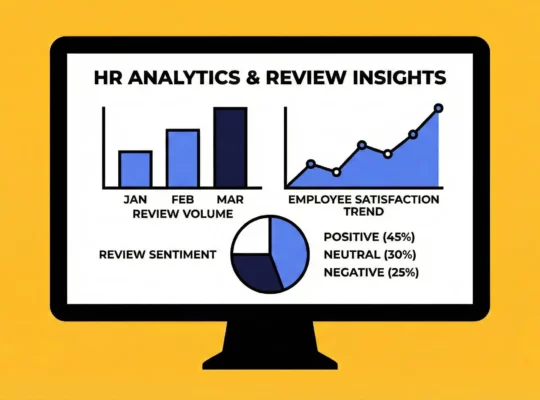Employer branding best practices are crucial for any organization aiming to stand out in today’s highly competitive job market. This foundational strategy extends beyond mere recruitment; it shapes public perception and internal culture, making it a key component of a company’s success. At Review.jobs, we recognize that a compelling employer brand not only attracts top-tier talent but also significantly enhances retention and engagement among current employees. In the next sections, we will explore the definition and critical importance of employer branding, highlighting its impact on modern business practices.
Table of Contents
Understanding the Basics of Employer Branding
What Constitutes an Employer Brand?
An employer brand is the market perception of what it’s like to work for an organization. It is the image that potential, current, and past employees have in their minds about the employment experience at a company. This brand encompasses several elements:
- Company values: What the company stands for and its principles.
- Employee Value Proposition (EVP): The array of benefits and opportunities provided to employees, which distinguish a company from its competitors.
- Company culture: The working environment and social norms at the company.
- Work-life balance: How the company supports employees in balancing their work and personal lives.
- Career development opportunities: The paths available to employees for personal and professional growth.
- Company reputation: Public perception and recognition of the company as an employer.
The Relationship Between Employer Brand and Corporate Brand
While they are distinct, the employer brand and the corporate brand are closely intertwined. The corporate brand reflects the organization’s identity in relation to its consumers, showcasing its products or services, customer service, and market position.
The employer brand, on the other hand, focuses on the company as an employer and is targeted at current employees, potential candidates, and other stakeholders in the job market.
The synergy between these two types of branding is essential for a cohesive brand strategy. A strong employer brand supports the corporate brand by fostering a positive internal culture that spills over into customer interactions. Conversely, a robust corporate brand can enhance the attractiveness of the employer brand by elevating the company’s status and desirability as a place to work.
Together, they form a comprehensive brand strategy that aligns external perceptions with internal realities, ensuring that the company is viewed favorably by both consumers and job seekers. This alignment helps attract and retain top talent, crucial for driving business success and innovation.
Key Elements of Effective Employer Branding
Effective employer branding hinges on several pivotal elements that help companies attract and retain top talent while reinforcing their market position as preferred employers. These elements ensure that the branding messages resonate authentically and consistently across various platforms and interactions.
Authenticity and Transparency
A strong employer brand is rooted in authenticity and transparency. These qualities are critical because they build trust—a fundamental component in any relationship, including those between employers and their employees.
For employer branding to be effective, it must reflect the true nature of the company’s working environment, values, and culture. Authenticity in employer branding involves:
- Honest communication: Sharing the realities of working at the company, including both the benefits and the challenges.
- Real stories from real employees: Using testimonials and case studies from current and former employees to provide a genuine insight into the company culture.
- Clear messaging: Ensuring all branding materials accurately reflect what the company stands for and what it offers to its employees.
Transparency not only helps in setting the right expectations but also diminishes the chances of employee turnover due to mismatched expectations. It encourages a more informed decision-making process for potential employees and fosters a culture of openness within the organization.
Employee Value Proposition (EVP)
The Employee Value Proposition (EVP) is a set of offerings provided by an employer in return for the skills, capabilities, and experiences an employee brings to the organization. An effective EVP is crucial for differentiating a company from its competitors in the job market.
Key components of an EVP include:
- Compensation and benefits: Not just salary, but also health benefits, pensions, bonuses, and other financial incentives.
- Work environment: The physical and psychological aspects of the workplace, including office layout, remote working options, and the overall atmosphere.
- Career development: Opportunities for growth and advancement within the company, such as training programs, mentorship, and promotions.
- Company values and mission: How well the personal values of the employees align with those of the company.
- Recognition and rewards: Acknowledgment of employee achievements and contributions to the company.
Consistency Across All Touchpoints
For employer branding to be successful, it must be consistent across all touchpoints. This consistency helps to reinforce the brand message and ensures that potential and current employees have a uniform experience at every point of contact with the company. This includes:
- Recruitment: Advertisements, job descriptions, and interview processes that align with the employer brand.
- Onboarding: Ensuring new hires experience the company culture they were promised during recruitment.
- Internal communications: Regular updates and transparent communication channels that keep employees informed and engaged.
- Social media and online presence: Maintaining a consistent brand voice and message across all social media platforms.
- Employee advocacy: Encouraging employees to share their genuine experiences on social media, which can serve as powerful testimonials to the employer brand.
By focusing on these key elements, organizations can develop a robust employer branding strategy that not only attracts but also retains skilled professionals, ultimately contributing to sustained organizational growth and success.
Best Practices in Developing Employer Branding
Developing an action plan for a compelling employer branding strategy requires a multifaceted approach that incorporates the vision of the leadership, the voices of employees, the power of storytelling, and a commitment to diversity, equity, and inclusion (DEI).
Here are some best practices that can help organizations build a strong employer brand that resonates with both current employees and potential candidates.
1. Involve Leadership and Ensure Alignment with Business Goals
Leadership involvement is critical in defining and promoting the employer brand. When company leaders actively participate in employer branding, it demonstrates a commitment to the values and culture they wish to project. Best practices include:
- Leadership visibility: Leaders should be visible champions of the brand, engaging with employees and candidates through various channels such as social media, town hall meetings, and company events.
- Alignment with business objectives: The employer branding initiatives should be directly aligned with the overall business strategy, ensuring that they contribute to achieving business goals and enhancing the organization’s market position.
- Consistent communication: Leaders should consistently communicate the company’s values and long-term vision to all stakeholders, helping to embed these elements into the employer brand.
2. Engage Employees as Brand Ambassadors
Employees are the most credible advocates for a company’s employer brand. When they share their genuine work experiences, they help attract like-minded candidates and contribute to a realistic portrayal of the company culture. To effectively engage employees as brand ambassadors:
- Empower employees: Provide platforms and opportunities for employees to share their stories and experiences, both online and offline.
- Training and guidance: Offer training on brand messaging and social media best practices to ensure consistent and positive messaging.
- Recognition programs: Develop programs to recognize and reward employees who actively participate in employer branding efforts, thus encouraging ongoing engagement.
Use Storytelling to Share Brand Values and Culture
Storytelling is a powerful tool in employer branding, as it helps create an emotional connection with the audience. Effective storytelling can transform abstract company values into relatable narratives that vividly illustrate what the company stands for. Practices to enhance storytelling include:
- Employee stories: Share real stories that highlight employee achievements, day-to-day activities, and how they embody the company’s values.
- Visual content: Utilize videos, infographics, and photos to tell compelling stories that capture the essence of the company culture and work environment.
- Authenticity: Ensure that the stories are authentic and reflect the true nature of the company, avoiding exaggerated claims that could mislead job seekers.
Emphasize Diversity, Equity, and Inclusion (DEI)
A focus on DEI is not just a moral imperative but also a strategic advantage in today’s diverse workforce. A significant majority (80%) of survey participants prefer working for organizations that prioritize diversity, equity, and inclusion (DEI) initiatives and (76%) consider diversity a key factor when evaluating job opportunities. A brand that embraces diversity offers equitable opportunities, and fosters an inclusive environment is more appealing to a broader range of talent. To emphasize DEI in employer branding:
- Inclusive branding materials: Ensure that all branding materials reflect diversity in terms of race, gender, age, and other backgrounds.
- DEI goals and initiatives: Publicly share the company’s DEI goals and ongoing initiatives to demonstrate commitment.
- Employee feedback: Regularly collect and act on feedback from employees about the inclusiveness of the work environment.
By integrating these best practices into your employer branding strategy, your organization can enhance its reputation as an attractive employer that values its employees and is dedicated to creating a positive and inclusive work environment.
Utilizing Social Media and Digital Platforms
In the digital era, social media and digital platforms are indispensable tools for effective employer branding. They offer dynamic environments where companies can engage directly with job seekers, employees, and industry peers. Here’s how businesses can leverage these platforms to enhance their employer brand strategy.
Selecting the Right Platforms for Your Brand
Choosing the right social media platforms is crucial for reaching your target audience effectively. Each platform has a unique demographic and serves different purposes, so understanding where your potential and current employees spend their time online is key. Best practices include:
- LinkedIn: Ideal for professional networking and job postings, making it a must for any employer branding effort.
- Instagram and Facebook: Great for showcasing company culture through behind-the-scenes content, events, and employee spotlights.
- Twitter: Useful for quick updates, industry news, and engagement with followers through conversations and polls.
- YouTube: Excellent for sharing video content such as employer branding examples, office tours, and employee testimonials.
When selecting platforms, consider where your content will most likely resonate with your desired audience and where you can consistently manage your presence.
Content Strategies for Maximum Engagement
To maximize engagement on social media, your content needs to be strategic, appealing, and aligned with your brand values. Effective content strategies include:
- Regular posting: Maintain a consistent posting schedule to keep your brand top of mind.
- Diverse content types: Use a mix of text, images, videos, and live sessions to keep the content fresh and engaging.
- Employee participation: Encourage employees to contribute to content creation, providing a genuine view of your company’s work life.
- Engagement prompts: Include calls to action that encourage interaction, such as asking questions or encouraging followers to share their thoughts and experiences.
- Value-driven content: Share content that adds value to your followers, such as career tips, industry insights, and professional development opportunities.
Monitoring and Managing Your Online Reputation
Monitoring your online reputation is essential for maintaining a positive employer brand. This involves keeping track of what’s being said about your company across social media and other digital platforms and responding appropriately to feedback, both positive and negative. Effective reputation management practices include:
- Regular monitoring: Use tools like Google Alerts, Social Mention, and Hootsuite to stay updated on mentions of your company.
- Responsive engagement: Quickly respond to comments, questions, and reviews. Show that your company values feedback and is proactive about communication.
- Crisis management plans: Have a plan in place for addressing negative incidents or publicity to minimize potential damage to your employer brand.
- Positive reinforcement: Highlight positive reviews and testimonials from your employees and customers to enhance your brand’s public image.
Utilizing these strategies on social media and digital platforms not only strengthens your employer branding but also builds a robust channel of communication and engagement that can significantly influence how potential and current employees perceive your company.
In 2017, 55% of job seekers stated they’ve abandoned applying for a job after reading too many negative online reviews.
Measuring Employer Brand Success
To ensure the effectiveness of an employer branding strategy, it’s essential to measure its success using specific metrics and feedback mechanisms. Evaluating the impact of employer branding initiatives allows organizations to make informed decisions and refine their strategies over time.
Here’s how companies can measure the success of their employer branding efforts:
Key Performance Indicators (KPIs) for Employer Branding
Measuring the success of your employer branding efforts involves tracking various KPIs that reflect both the reach and the impact of your activities. Key indicators include:
- Application rate: The number of applications received per job posting, which can indicate the attractiveness of your brand to job seekers.
- Quality of hire: Assessments of new hires’ performance and their alignment with company values over time.
- Employee turnover rate: Particularly turnover among newly hired employees, which can signal the effectiveness of your branding in setting the right expectations.
- Engagement scores: Employee feedback on engagement and satisfaction, often gathered through internal surveys.
- Cost per hire: Reduction in recruitment costs as a result of a stronger brand attracting more and better candidates.
- Time to hire: The speed at which job vacancies are filled, indicating the efficiency and appeal of your employer brand.
Tools and Technologies for Tracking Brand Performance
Various tools and technologies can aid in tracking the performance of your employer branding initiatives. These include:
- Applicant Tracking Systems (ATS): These systems not only streamline the recruitment process but also provide data on application rates and hiring efficiency.
- Social Media Analytics Tools: Platforms like Sprout Social, Hootsuite, or Google Analytics can track engagement, reach, and conversion rates from social media posts and campaigns.
- Employee Survey Platforms: Tools such as SurveyMonkey or Google Forms can be used to conduct regular employee satisfaction surveys and gather feedback on the company culture.
- Brand Monitoring Tools: Services like Mention or Brand24 offer real-time monitoring of your brand’s mentions across the web, helping you gauge public perception.
Regularly Gathering Feedback and Insights from Employees
Continuous feedback from employees is vital for assessing the internal impact of your employer branding efforts. Regularly collecting and analyzing this feedback helps to:
- Understand employee perceptions: Insights into how employees view the company, its culture, and their work environment.
- Identify areas for improvement: Feedback can highlight gaps between the employer brand promise and the actual employee experience.
- Measure engagement and satisfaction: Regular surveys can track changes in employee engagement, satisfaction, and loyalty, which are directly influenced by the effectiveness of your employer branding. Methods for gathering employee feedback include:
- Annual or bi-annual surveys: Comprehensive surveys that cover all aspects of the employee experience.
- Pulse surveys: Short, frequent surveys that keep track of employee sentiment in real-time.
- Exit interviews: Interviews with departing employees that can provide insights into the reasons behind their decision to leave, which might be related to mismatches in employer branding.
By effectively measuring these aspects of employer branding, organizations can continuously refine their strategies to better attract and retain top talent, ensuring their employer brand remains strong and effective in a competitive marketplace.
Challenges in Employer Branding
While implementing a robust employer branding strategy is critical for attracting and retaining top talent, several challenges can arise during its execution. These obstacles can stem from internal misconceptions or external criticisms. Understanding these challenges and knowing how to effectively address them is crucial for maintaining a positive employer brand.
Overcoming Common Obstacles and Misconceptions
Several misconceptions about employer branding can hinder its effectiveness. These include:
- Misconception: It’s just HR’s responsibility: Employer branding is often thought to be solely an HR concern, but it actually requires the involvement of multiple departments including marketing, management, and even finance to ensure alignment and coherence across the company.
- Misconception: Instant results: Some companies expect immediate results from employer branding initiatives. However, building a strong employer brand is a long-term effort that requires persistence and consistency.
- Misconception: Employer branding is only about recruitment: While attracting new talent is a significant aspect, employer branding also plays a crucial role in employee retention and engagement.
To overcome these obstacles: - Educate and involve: Educate stakeholders across the company about the benefits of employer branding and involve them in the strategy formulation and execution.
- Set realistic expectations: Communicate that employer branding is a long-term investment and set realistic timelines for when results can be expected.
- Highlight internal benefits: Show how a strong employer brand can improve work environment, employee satisfaction, and overall company performance.
Addressing Negative Feedback and Public Perception
Negative feedback, whether it comes from former employees or social media users, can significantly impact an employer’s brand. Managing this feedback effectively is crucial for maintaining a positive public image. Strategies to address negative feedback include:
- Prompt and respectful responses: Always respond to negative comments swiftly and respectfully. Acknowledge the issue and explain what is being done to address it.
- Transparency: Be transparent about challenges and what the company is doing to improve. This can help mitigate the impact of negative feedback by showing a commitment to continual improvement.
- Proactive reputation management: Regularly monitor social media channels and employer review sites to stay on top of what people are saying about your company. Use this information to improve practices and address any recurring issues.
- Engage with the community: Actively engage in community activities and social media discussions to build and maintain a positive brand image. Highlighting positive initiatives and company values can counterbalance occasional negative feedback.
By effectively addressing these challenges, companies can enhance their employer branding efforts and ensure that their employer brand remains strong and appealing to both potential job seekers and current employees. This proactive approach to managing obstacles and feedback is essential for maintaining a favorable employer brand in the competitive job market.
Future Trends in Employer Branding
As we look towards the future, employer branding is set to evolve with advancements in technology and changing societal values. Understanding these trends can help organizations stay ahead, ensuring that their employer branding strategies remain effective and relevant. Here’s a look at how technology and innovation are shaping the future of employer branding and some predictions on its evolution.
The Impact of Technology and Innovation on Employer Branding
Technology plays a pivotal role in transforming employer branding strategies through new tools and platforms that enhance how companies engage with potential employees and manage their brand reputation. Significant technological impacts include:
- Artificial Intelligence (AI) and Machine Learning (ML): AI and ML are being used to personalize the job seeker’s experience, from customized job recommendations to tailored company insights that match their career aspirations. This technology also helps in analyzing employee data to identify trends and improve employer branding strategies.
- Virtual Reality (VR) and Augmented Reality (AR): These technologies are increasingly being used for virtual office tours, realistic job previews, and immersive employee training programs, providing a more engaging way for candidates to connect with a company’s environment and culture.
- Data Analytics: Enhanced analytics help companies measure the effectiveness of their employer branding efforts more accurately, enabling them to make data-driven decisions to attract and retain talent.
Predictions for How Employer Branding Will Evolve
Looking forward, the following are some key predictions on the evolution of employer branding:
- Increased focus on employer brand differentiation: As the job market becomes more competitive, companies will seek innovative ways to differentiate their employer brands. This could include unique employee benefits, unusual work environments, or cutting-edge career development opportunities.
- Greater emphasis on social and environmental responsibility: Potential employees, especially millennials and Gen Z, are increasingly interested in working for companies that demonstrate a commitment to social and environmental issues. Employer branding will increasingly reflect company values and actions in these areas to attract conscientious talent.
- Integration of employer branding into employee wellness: With a growing focus on mental health and overall well-being, future employer branding efforts will likely highlight work-life balance, mental health initiatives, and wellness programs.
- Use of social media as a two-way communication tool: Beyond just a broadcasting channel, social media will evolve as a critical two-way communication tool where potential and current employees can engage directly with companies, offering feedback and participating in brand advocacy.
By staying attuned to these trends and integrating new technologies and societal values into their strategies, companies can ensure that their employer branding remains strong and appealing in a rapidly changing world. This proactive approach will be essential for attracting and retaining the next generation of talent and maintaining a competitive edge in the market.
Conclusion
Throughout this article, we’ve explored the critical components and best practices of effective employer branding. From understanding its definition and importance in the modern job market to utilizing social media and addressing challenges, it’s clear that a strong employer branding strategy is pivotal for attracting and retaining top talent. As we’ve seen, employer branding not only enhances a company’s appeal to potential candidates but also plays a crucial role in overall business success.
Key Points Summary:
- Employer branding is a comprehensive approach that involves more than just the HR department; it requires the integration of efforts across the entire company.
- The elements of authenticity, transparency, and consistency are essential in conveying an employer’s true culture and values.
- Engaging employees as brand ambassadors and utilizing storytelling are powerful strategies for sharing a company’s brand narrative.
- Leveraging social media platforms effectively can amplify an employer’s brand and help manage its online reputation.
- Ongoing measurement and adaptation of employer branding strategies are necessary to ensure they remain effective and aligned with company goals.
Now is the time for businesses to invest in their employer branding. In an increasingly competitive job market, a robust employer branding strategy is no longer just an option—it is a necessity. By fostering a positive work environment, actively engaging with employees and job seekers, and continuously adapting to new trends and technologies, companies can ensure that they attract and retain the skilled employees they need to thrive. Invest in your employer branding today and build a foundation that will attract the best talent and drive your company’s future success.





